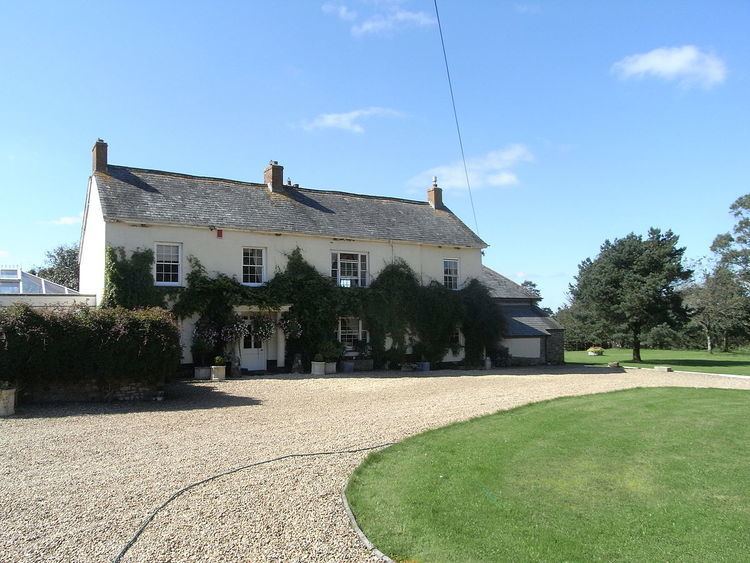 | ||
Way is a historic estate in the parish of St Giles in the Wood, Devon. It is situated about 2 miles north-east of the village of St Giles in the Wood and about 4 miles north-east of the town of Great Torrington. It was described by Hoskins (1959) as "the fons et origo of the mighty tribe of Pollard" and had been acquired by them from the de la Way family at some time before 1242. One of the earliest members descended from this family to reach national prominence was Sir Lewis Pollard (c. 1465-1526), Justice of the Common Pleas, of Kings Nympton. The former mansion of the Pollards at Way is now represented by the farmhouse known as Way Barton. Reset into the front wall of the house is a stone sculpture dated about 1300 showing the faces of two ladies wearing wimples and above them the smaller face of a man. In 1309 Robert Pollard was granted by the Bishop of Exeter licence to build an oratory at Weye, of which no trace remains in the present house.
Contents
de la Way
The Devon historian Tristram Risdon (died 1640) (who lived at Winscott in the same parish of St Giles in the Wood) stated Way to have been the residence of the de la Way family during the reign of King John (1199-1216), and to have been granted, during the reign of Edward I (1272-1307), by Walter de la Way, the son of William de la Way, to Walter Pollard, which grant was witnessed by Sir Henry Sully and Sir Thomas Merton.
The arms of de la Way were later quartered by their descendants the Pollard family and by the Davie family (later Davie Baronets of Creedy, Sandford). The usual explanation of this usage of the de la Way arms is as given for example in the 1771 Baronetage of England, by Kimber and Johnson:
"The inhabitants of this seat" (i.e. Way, erroneously said to be situated in the parish of Horwood, another Pollard seat) "and ancestors of this family, were first of all known by the name of De-la-Wey, and the first of them mentioned in their pedigree had coat armour, which hath ever since continued the fame to this family, although their names have diversly been written, De-la-Wey, then Dewy, De-Vie, and afterwards contracted and softened into Davie; unto which variation it was the more subject, for that many hundred years since, one Walter Pollard, matching with the daughter and heir-general of this family, became owner of the said ancient habitation, called Wey, which gave name to the family, as aforefaid, and which, ever since the said marriage, hath continued with the Pollards, who, in respect of that match, do also, at this day, quarter the coat of the Davies".The family of Davie of Creedy is said by the Devon topographer Rev. Swete (died 1821) to have derived from the family of de Way (Latinised to de Via, of which "Davie" is said to be a corrupted form) of the manor of Way in the parish of St Giles in the Wood, near Great Torrington, Devon. The family of Pollard inherited (or purchased) the manor of Way, which became their fons et origo, and according to Prince, (died 1723) adopted these "de Way"/Davie arms which thenceforth they used either alone or quartered by their own arms of Argent, a chevron sable between three escallops gules. The Pollard family inherited the manor of Horwood from the Cornu family and these de Way mullet arms are visible on their own, without the Pollard escallop arms, on several 17th-century Pollard monuments in Horwood Church.
Pollard
Vivian (1895) gave the descent of Way in the Pollard family as follows:
Orate pro bono statu Johannis Pollard et Emmae uxoris eius qui istam guildam fieri fecerunt (pray for the good position of John Pollard and of Emma his wife who made this guild to come into being)
This evidences their having established a guild in that church. In Prince's opinion it was Horwood not Way which was the earliest devonshire home of the Pollard family. The 3rd son of John Pollard and Emme Doddescombe was Roger Pollard, who founded the Pollard family of Langley, Yarnscombe.
Hic jacet Alyanora Pollard qui fuit uxor Joh(ann)is Pollard et filia Joh(ann)is Copleston qui obiit xxi die mensis Septembris Anno d(o)m(in)i Mill(ensi)mo CCCCXXX cuius animae propitietur Deus Amen. (Here lies Eleanor / Alianore Pollard who was the wife of John Pollard and daughter of John Copleston who died on the 21st day of the month of September in the One thousandth four hundredth and thirtieth year of Our Lord of whose soul may God look upon with favour Amen.)
There are two further inscriptions on the same slab made later to commemorate two distant relations:
The 2nd son of John II Pollard and Eleanor Copleston was Robert Pollard, whose eldest son was Sir Lewis Pollard (c. 1465 – 1526), Justice of the Common Pleas from 1514 to 1526 and MP for Totnes in 1491, founder of the most influential branch of the Pollard family seated at Kings Nympton in Devon, from whom descended the Pollard Baronets.
By this date the Pollard family had abandoned Way as a residence in favour of Horwood.
Wellington
Way became later the property of Lewis Wellington, living there when Risdon wrote his Survey of Devon (c. 1630). In a deed of 1611 Lewis Wellington of Great Torrington was described as a "woollen draper". In 1651 Thomas Wellington was mayor of Great Torrington.
Furse
The heiress Grace Wellington (1719-1763) brought the property to the family of her husband Philip Furse (1709-1774) of Dolton. Her son was Rev. Peter Wellington Furse (1755-1832), the owner of Way in 1810. The painter Charles Wellington Furse (1868-1904) was a member of this family. The Furse family owned the Halsdon Estate in Dolton from the later 17th century and lived there until the house was sold in 1982.
